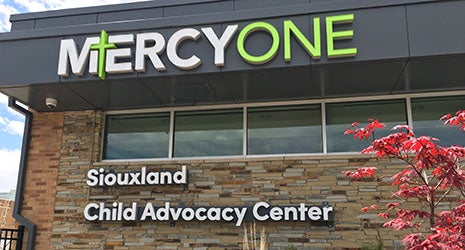MercyOne Siouxland Child Advocacy Center

Hours
MercyOne Siouxland Child Advocacy Center is a comprehensive, child-friendly program dedicated to serving child victims of abuse. Our multi-disciplinary team of caring professionals supports child victims through each phase of the abuse response, including detection and investigation of abuse, as well as treatment and follow-up services for child victims.
Since opening in 1989, MercyOne Siouxland Child Advocacy Center has served over 21,000 children. In 2020, the Omaha FBI field office recognized MercyOne Child Advocacy Center with the Director’s Community Leadership Award on behalf of their efforts to combat violence in the tri-state area.
Interviews are only conducted for open DHS cases. To report suspected child abuse, call the Child Abuse Hotline at 1-800-362-2178.
Services
- Child abuse
- Forensic and evidentiary interviews
- Legal, emotional, medical and spiritual family support
- Pediatric Specialties
Procedures
- Trauma evaluations
- Evaluations for general mental health or behavioral concerns
- Ongoing trauma-focused therapeutic services
The "why" behind MercyOne Siouxland Child Advocacy Center
The MercyOne Siouxland Child Advocacy Center is a comprehensive, child-friendly program dedicated to serving child victims of abuse. Our multi-disciplinary team of caring professionals supports child victims through each phase of the abuse response, including detection and investigation of abuse, as well as treatment and follow-up services for child victims.
Through advocacy efforts and diverse educational offerings, our team is committed to the prevention of child abuse.
Since opening in 1989, the MercyOne Siouxland Child Advocacy Center has served more than 20,000 children. It is one of 250 full members of the National Children's Alliance, a nationwide not-for-profit organization that assists communities seeking to improve their response to child abuse.
MercyOne Siouxland Child Advocacy Center is utilized by law enforcement and Child Protective Services in child abuse investigations, allowing the abused to tell their story, keeping them safe and protecting their dignity. No family will ever pay a penny for our services. That is a promise of our mission.
For more information, or to donate to the MercyOne Siouxland Child Advocacy Center, please call 712-279-2548 or email Victoria Ricke.
Mental health services
All services are free of charge
Our services are designed to address trauma-focused mental health concerns in children and adolescents. Clinicians are guided by the National Children's Alliance: Evidence Based Mental Health Treatments for Child Abuse Victims standards.
We provide the following services for children:
- Trauma evaluations
- Evaluations for general mental health or behavioral concerns
- Ongoing trauma-focused therapeutic services
- To request mental health services, call 712-279-2548.
Reporting suspected abuse
Child victims of abuse are referred to MercyOne Siouxland Child Advocacy Center by the Department of Human Services (DHS), or law enforcement agencies. However, anyone may call MercyOne Siouxland Child Advocacy Center for information or referrals regarding suspected child abuse and prevention of child abuse: 712-279-2548 or 1-800-582-0684.
MercyOne Siouxland Child Advocacy Center does not replace or duplicate the work of the Department of Human Services (DHS) or law enforcement agencies. To report suspected child abuse contact:
In Iowa
Department of Human Services (DHS)
From anyplace in Iowa, call the 24-hour hotline: 1-800-362-2178
Or call your local DHS, 8 a.m. to 4:30 p.m. Monday through Friday
Woodbury County DHS: 712-255-2699
Law enforcement
Sioux City Police Dept.: 712-279-6960
Woodbury County Sheriff's Dept.: 712-279-6010
Or call your local police or sheriff's department
In Nebraska
24-hour hotline: 1-800-652-1999
Or call your local Department of Health and Human Services
Dakota County: 1-402-987-3445
Law enforcement
South Sioux City Police Dept.: 1-402-494-7512
Dakota County Sheriff: 1-402-494-7555
Or call your local police or sheriff's department
In South Dakota
Department of Social Services (DSS)
24 hour hotline: 877-244-0864 or call your local law enforcement (police department or county sheriff's office).
Services
- Mental Health
- Behavioral Health
- Pediatric Specialties
- Child abuse
